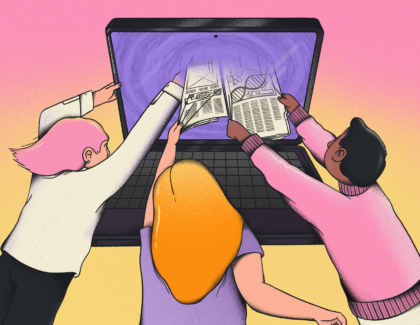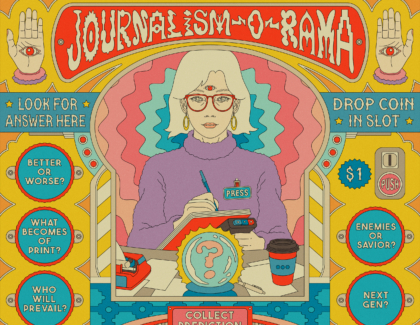Sign up for the daily CJR newsletter.
This past July, when a gunman attempted to fire eight rounds at Donald Trump at a campaign rally in Pennsylvania, a singular image emerged in the aftermath: the presumptive Republican candidate surrounded by Secret Service agents, his fist in the air. Depending on the frame, Trump’s expression was either defiant or victorious.
Of the ten largest newspapers in the United States by circulation, eight featured that moment as the lead front-page photo that Sunday or Monday morning. The Wall Street Journal published it as well, albeit as a small thumbnail beneath an aerial image of the shooter’s home being surrounded by law enforcement. Only Long Island’s Newsday deviated from its peers, showing Trump during a more chaotic moment from seconds before, his gaze fixed in the distance, his head tightly framed by an outstretched agent’s arm.
Photo desks are rarely so unanimous in their decision-making. We didn’t see this level of synchronicity in 2021, the day after the January 6 insurrection at the Capitol, or in 2006, during the aftermath of Hurricane Katrina, or in 2001, after the September 11 attacks. But Trump is a career showman, who seized the opportunity to create a photo op (over the objections of the Secret Service). For the journalists who happened to capture that moment from just in front of the stage—Evan Vucci of the Associated Press, Anna Moneymaker of Getty Images, Doug Mills of the New York Times, and Jabin Botsford of the Washington Post—it became the shot of a lifetime. Trouble is, that’s exactly what Trump wanted.
We know from the 2016 race that Trump commands more free media attention than any other presidential candidate in US history. According to mediaQuant, a data analysis firm, during his 2016 campaign alone, he received 5.9 billion dollars in free coverage—more than twice what Hillary Clinton brought in. In 2020, per Harvard’s Shorenstein Center, Trump received four times as much coverage as Joe Biden on CBS, and three times as much on Fox. This time around, we have continued the pattern, positioning him as the main visual character of every story. Ultimately, that serves his interests. Perhaps no candidate has been more masterful at commanding his own image than Trump, who leveraged his glowering mug shot into a reported 7.1 million dollars in campaign funds.
In recent days, news posts on Instagram—which, according to the Pew Research Center, this year surpassed TikTok, X, and Reddit as a primary source of news for Americans—overwhelmingly featured Trump’s visage: Trump in a suit at a crypto conference, fist raised. Trump at a 2017 event with tech executives, pointing aggressively. Trump at a rally, fist raised. Trump at Madison Square Garden, arms outstretched. Trump emerging from backstage, pushing a plush curtain aside. Trump, Trump, Trump.
Historically, the central tension for photojournalism has been inverted: it tends to be easier for us to document the lives of the vulnerable, the marginalized, and the oppressed than it is for us to show the forces responsible for their conditions. For every story about Purdue Pharma and the Sackler family’s role in overprescribing OxyContin, we have seen hundreds, perhaps thousands, of images of Americans struggling with opioid addiction. We consume far more visuals of the aftermath of gun violence than of the lobbyists, politicians, and NRA leaders responsible for fighting gun control measures in Congress. We publish constant imagery of asylum seekers trying to cross the US-Mexico border without visually contextualizing what they are fleeing. The photographs—often moving and vulnerable—are the result of work that happens outside the realm of publicists and press secretaries.
And yet for every story about a new threat to transgender people or proposed mass deportations, almost every major American news outlet has pivoted to showing Trump as the root cause of our impending descent into fascism. It seems the American media has forgotten that one of its core duties is to be oppositional to power; instead of centering what is at stake, we have made Trump the strongman poster child for his own political violence. In the event of a second Trump administration, we cannot allow ourselves to continue documenting his political theater.
News photographs tell stories, but they can also be metaphors: for what is important, for what we choose to value. Instead of Trump, show us Sarah McBride, projected to be the first openly transgender member of Congress and already the highest-ranking transgender elected official in US history. Show us Rebekah Bruesehoff, the teenage trans-rights activist who has been advocating for her community since she was ten. Show us Chris Mosier, the athlete who campaigned for the International Olympic Committee to make its policies more inclusive and became the first out trans athlete to join a US national team. Show us what we could lose.
In the days after July’s assassination attempt, another photo surfaced. Moneymaker, of Getty Images, had somehow managed to catch Trump immediately after he was grazed and took cover. We see him between the legs of a kneeling agent, crouching on the ground behind a bulletproof barrier, a few rivulets of blood running down his cheek, his mouth open—not in a war cry to his fans, but in an expression that looks like surprise. The image was not the product of a reality television star’s thirst for attention. It was raw—and revealed far more about the significance of the prior few minutes than his orchestrated fist pump. If we must continue to show Trump, show him as he really is.
Has America ever needed a media defender more than now? Help us by joining CJR today.







